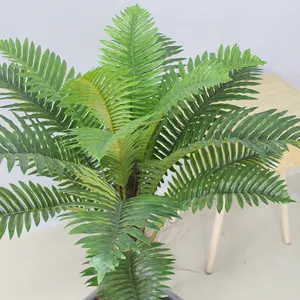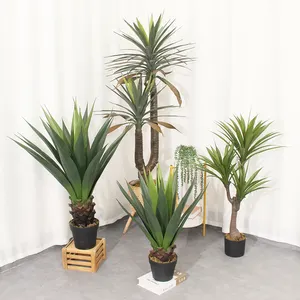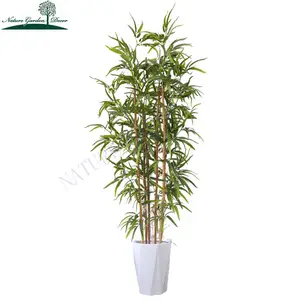Introduction
For those seeking a low-maintenance, evergreen garden, fake landscaping plants have emerged as an unexpected solution. These artificial alternatives to natural flora offer numerous benefits, including cost-effectiveness and allergy elimination. However, they also present unique challenges, such as environmental concerns and maintenance needs. This article delves into the world of fake landscaping plants, exploring their types, benefits, costs, and how to choose and maintain them effectively. It also addresses the environmental impact of these artificial plants, providing a comprehensive guide for those considering this unconventional gardening approach.
Understanding Fake Landscaping Plants
Fake landscaping plants, often mistaken for their natural counterparts, have both advantages and disadvantages. While they don't actively clean the environment like real plants, they can require more cleaning than you might expect. Their colors, particularly in the case of fake flowers, can fade quickly. Additionally, they can have a negative environmental impact. However, they also offer certain advantages that make them a viable option for some.
Types of Fake Landscaping Plants
Fake landscaping plants come in a variety of types. Artificial outdoor plants can fill gaps and provide year-round interest. Outdoor bushes add color and texture. Artificial outdoor grasses and ferns offer a different look and feel. Artificial outdoor trees can have a significant impact on the look of a space. Artificial outdoor palm trees bring a tropical air to your yard. Each type has its unique features and benefits, offering a low-maintenance alternative to real plants.
Benefits of Using Fake Landscaping Plants
Artificial plants offer five key benefits. They are cost-effective, requiring only an upfront cost and no ongoing maintenance expenses. They demand significantly less maintenance than real plants, needing only occasional dusting. Artificial plants allow you to create the aesthetic you want without environmental limitations. They also offer wellbeing benefits, improving mood, morale, productivity, and focus. Lastly, they eliminate allergy issues associated with real plants, making them a safe choice for everyone.
Cost and Durability
Artificial plants in this category cost $25-$50, offering basic designs and quality. Midrange artificial plants fall between $50-$100, mostly plastic and low-maintenance. The most expensive artificial plants cost over $100, offering high-quality, durable plants and substantial value for your money. These are long-term investments, so it’s okay to spend a decent amount of money on these plants as they will stay with you for a while. Also, plants made with plastic are more durable than fabric plants, resistant to water and heat, which makes them easy to maintain.
How to Choose the Right Fake Plants for Your Garden
Choosing the right artificial plants for your garden depends on your aesthetic preferences, climate, and maintenance capabilities. For instance, artificial outdoor plants can fill gaps and provide year-round interest. If you want a tropical vibe, consider artificial palm trees. They're weatherproof, UV resistant, and instantly add height to your garden. For a zen-like feel, an artificial maple tree or bamboo plants are ideal. If you're looking for privacy, consider bamboo trees or Areca palms that can form an attractive screen. Remember, high-quality artificial plants should look realistic and blend seamlessly with your garden's natural elements.
Installation and Maintenance Tips
To make your fake landscaping plants look real, it's crucial to secure them properly in pots. Start by upgrading the plastic container to a more appealing one that fits your design style. You can add real elements like dirt, rocks, and moss at the base of your fake plant. If you have pets that might disturb the dirt, using moss is a practical alternative. Remember, the key to making a fake plant look real is to add real elements to it, but at the base, not into the plant itself. These simple steps can help you achieve a more realistic look for your fake landscaping plants.
Environmental Impact of Fake Landscaping Plants
Artificial landscaping plants, often made from plastic, pose significant environmental concerns. Plastic, a non-decomposable material, persists in the environment indefinitely, contributing to soil and water contamination. While some artificial plants are claimed to be recyclable, the reality is complex due to the mix of materials used in their production. Moreover, plastic releases volatile organic compounds (VOCs) into the air, potentially causing health issues. Despite their aesthetic appeal and low maintenance, the environmental and health risks associated with artificial plants cannot be overlooked.
Conclusion
Fake landscaping plants offer a unique solution for those seeking a low-maintenance, evergreen garden. They come in a variety of types, each with its unique features and benefits. While they offer cost-effectiveness, less maintenance, and the ability to create a desired aesthetic without environmental limitations, they also pose significant environmental concerns. Choosing the right artificial plants for your garden involves considering your aesthetic preferences, climate, and maintenance capabilities. Proper installation and maintenance can enhance their realism, but the environmental impact of these plastic-made plants cannot be overlooked. Therefore, while fake landscaping plants can be a viable option for some, it's crucial to weigh their pros and cons before making a decision.







































 浙公网安备 33010002000092号
浙公网安备 33010002000092号 浙B2-20120091-4
浙B2-20120091-4